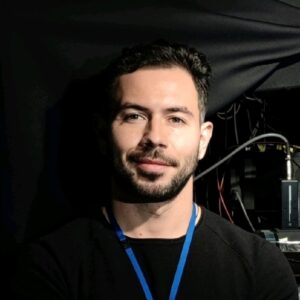Kamermans Group
Vision & Nystagmus

Vision & Nystagmus
Nystagmus, or ‘shaking eyes’, is an eye movement disorder. Studies in very young children with nystagmus have shown that the cause of this disorder does not lie in the brain, but in the retina. In the future, special glasses may be able to prevent these children from developing poor vision later in life.
The Retina Signal Processing lab at the Netherlands Institute for Neuroscience investigates how vision works.
Vision starts in the retina where images are transformed and coded into neuronal activity relevant for the brain. These coding steps function optimally over a wide range of conditions: from bright day on the beach to a moonless night. Under these very different conditions, specific retinal mechanisms continue to select relevant aspects of the visual world and send this information to the brain.
We are studying the neuronal processing involved in these selection and adaptation processes. This knowledge is essential for understanding how the visual system works and forms the basis for research dedicated to restoring vision in blind people.
Our eyes are constantly moving to and for a little bit. This is actually necessary; if this oscillation is eliminated we cannot see. But if the oscillations become too large, as is the case with the eye movement disorder nystagmus, this will lead to night blindness and bad eyesight later in life. Strangely enough this bad eyesight does not improve when the excessive shaking is eliminated. Apparently the cause lies somewhere else.
It has taken retina specialist Kamermans ten years to discover the mechanism behind it. ‘It has been difficult to find funding for this research’, he explains. ‘Everyone said: “The cause of nystagmus does not lie in the eye, it lies in the brain.”’ But Kamermans kept exploring the functioning of one particular synapse in the retina. This synapse consists of a unique combination of proteins that are only found in the retina and that ensure that we see sharp, stable images.
After he had given a talk somewhere about this synapse, an ophthalmologist told him that he had very young patients with both nystagmus and mutations in these proteins. Further investigation produced proof that it was precisely this specific synapse that was defective in these babies and toddlers. Kamermans: ‘It renders the signal processing in the retina very unstable and this results in a shaky signal. That shaky signal is then sent to the brain, and the brain thinks: I detect a moving image, when there is in fact no moving image. The brain then goes on to compensate for the moving image by creating unnecessary eye movements.’
The patients with this disorder – they were all between 3 months and 2 years old during this study – were unable to keep their eyes upward; they kept lowering them. This passed after two years’ time, but the children kept making jerky, horizontal eye movements. Kamermans: ‘It also turned out that their eyesight was not sharp, and that remained the case even when they were unable to move their eyes.’ He thinks that this is due to the fact that too many cells in their brains go on shaking simultaneously. ‘Cells that should be turned off at some point, keep going. This causes a mishmash of connections in the brain instead of a neat pattern. That chaos probably underlies their bad eyesight.’
Kamermans is now researching non-invasive methods to solve this problem. One possible solution is a pair of glasses with horizontal stripes. The idea is that those stripes would make the brain cells involved step in line, which might then lead to the correct connections being made in the brain. ‘It would be fantastic if we could enhance the sharpness of these children’s eyesight by letting them wear these glasses for a couple of hours a day.’ He is hopeful about a lasting effect if this is done early on in their lives. ‘We can then make use of the huge plasticity of these very young brains. By the time the plasticity has diminished, the situation is relatively stable and the problem might be solved. But,’ he says emphatically, ‘we still have a long way to go. For now there is still a lot of experimental work that has to be done.’

staff
See profile
PhD student
See profile
Postdoc
See profile
Head of department
See profile
Technician
See profile
Postdoc
See profile
PhD student
See profileAt the moment, there are no vacancies within this group
Show all vacancies
"*" indicates required fields
"*" indicates required fields
![]()
![]()
You can also transfer your contribution to NL76 INGB 0002 1673 78 in the name of ‘Stichting Vrienden van het Herseninstituut’
The Friends Foundation facilitates groundbreaking brain research. You can help us with that.
Support our work